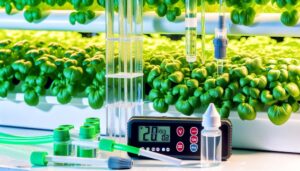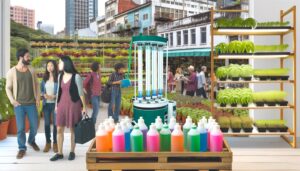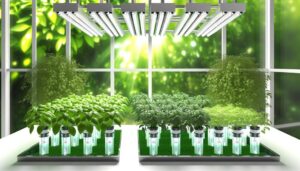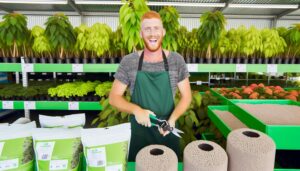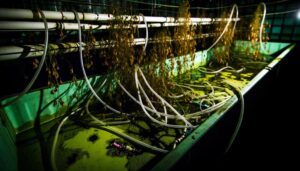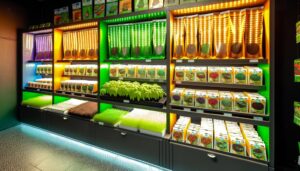What Hydroponics Solution Works Best for Strawberries
For the best hydroponic solution for strawberries, we've found Nutrient Film Technique (NFT) stands out due to its efficient nutrient delivery and oxygenation. NFT continuously flows a thin film of nutrient-rich water over roots, enhancing growth and minimizing water use.
Deep Water Culture (DWC) also shows promise with submerged, oxygenated roots guaranteeing robust nutrient absorption. Aeroponics delivers nutrients via mist, providing precise control and water efficiency.
Drip irrigation offers precision and scalability but less nutrient uptake efficiency. Balancing these methods with the right nutrient blend guarantees peak yield and plant health.
Explore further to master efficient strawberry hydroponics.
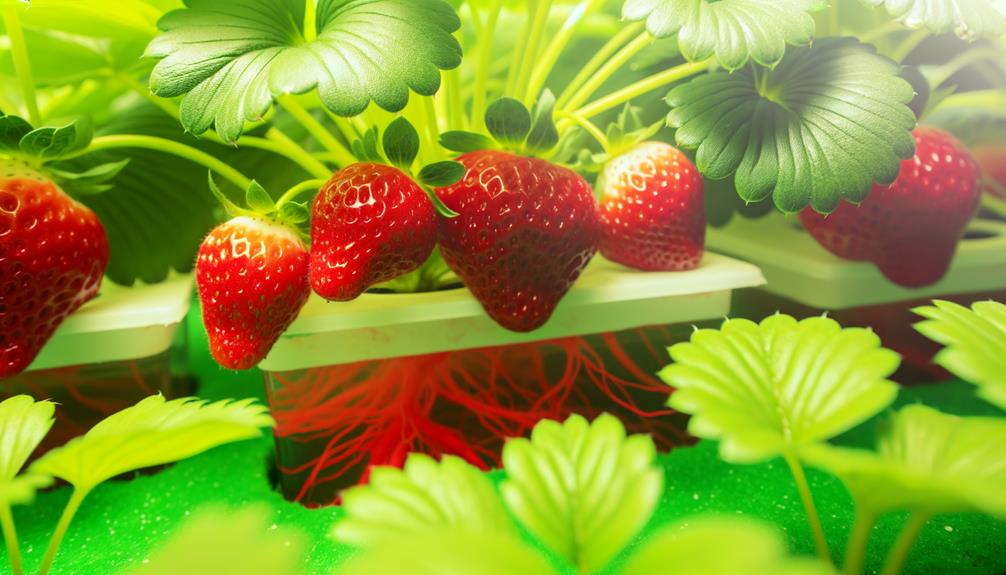
Key Takeaways
- NFT: Provides consistent nutrient and oxygen flow, ensuring optimal growth and minimizing water usage.
- DWC: Submerges roots in nutrient-rich, oxygenated water for enhanced yield and disease resistance.
- Drip Irrigation: Delivers controlled nutrients directly to roots, conserving water and reducing fungal risks.
- Aeroponics: Mists roots with nutrients, maximizing uptake and space efficiency while promoting sustainability.
Nutrient Film Technique (NFT)
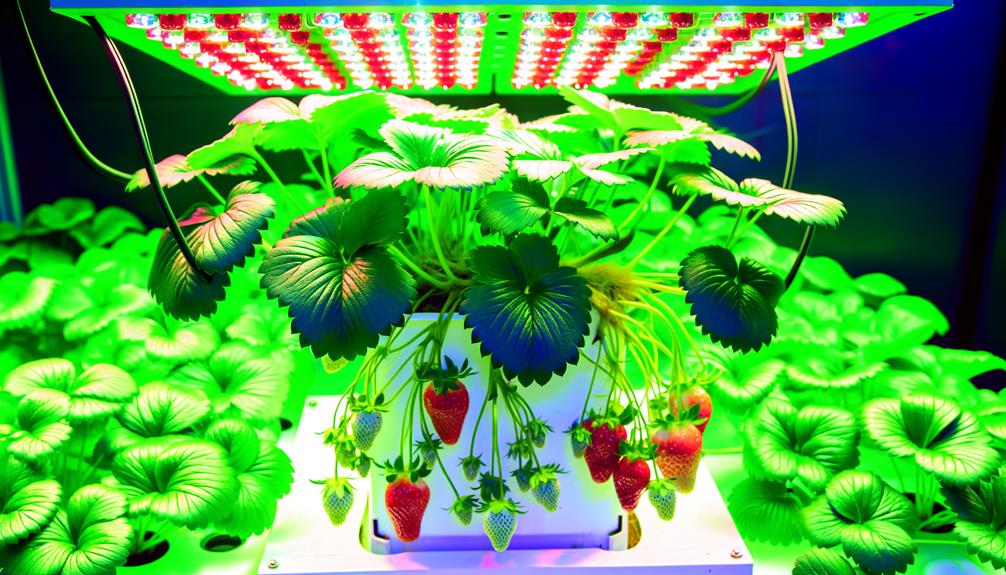
The Nutrient Film Technique (NFT) is a hydroponic method where a thin film of nutrient-rich water continuously flows over the roots of strawberry plants, providing ideal growth conditions.
By maintaining a consistent flow, we make certain roots receive a prime mix of oxygen and nutrients. This method minimizes water usage and promotes efficient nutrient uptake.
Using NFT, we can precisely control the nutrient concentration and pH levels, leading to healthier plants and higher yields. Additionally, the absence of soil reduces the risk of soil-borne diseases.
Our innovative approach leverages this technique to maximize space utilization and achieve faster growth cycles. NFT systems are scalable, making them perfect for both small-scale and commercial strawberry production.
Deep Water Culture (DWC)
In Deep Water Culture (DWC), we immerse the roots of strawberry plants directly into a nutrient-rich, oxygenated water solution, ensuring ideal nutrient absorption and accelerated growth rates.
This method leverages aeration devices to maintain dissolved oxygen levels, preventing root rot and promoting robust plant health.
By continuously submerging the roots, DWC eliminates soil-borne pathogens, reducing the risk of disease.
Additionally, it enables precise control over pH and nutrient concentration, optimizing conditions for strawberry cultivation.
Research shows that strawberries grown in DWC systems exhibit enhanced yield and fruit quality compared to traditional soil-based methods.
For those of us seeking innovative and efficient hydroponic solutions, DWC offers a compelling combination of simplicity, scalability, and superior plant performance.
Drip Irrigation Systems

Shifting our focus from Deep Water Culture, we now explore drip irrigation systems, which utilize emitters to deliver a controlled flow of nutrient solution directly to the root zone of strawberry plants, ensuring efficient water and nutrient use.
This method offers several advantages for innovative growers:
- Precision Control: Allows us to adjust the nutrient solution delivery to meet the specific needs of strawberry plants at different growth stages.
- Water Conservation: Reduces water usage by delivering nutrients directly to the root zone, minimizing runoff and evaporation.
- Scalability: Easily scalable for both small and large hydroponic setups, making it suitable for various production scales.
- Disease Prevention: Keeps foliage dry, reducing the risk of fungal infections and diseases.
Drip irrigation systems represent a precise, efficient option for hydroponic strawberry cultivation.
Aeroponics for Strawberries
Let's explore how aeroponics can revolutionize strawberry cultivation by maximizing nutrient delivery and enhancing root oxygenation.
Studies indicate that this method increases growth rates through efficient nutrient uptake and superior oxygen levels.
Additionally, aeroponics uses vertical space effectively, making it ideal for urban farming.
Efficient Nutrient Delivery
Aeroponics enhances nutrient delivery for strawberries by misting roots with a nutrient-rich solution, ensuring ideal absorption and growth.
This method optimizes the nutrient uptake efficiency, leading to robust plant health and increased yields. We see a significant improvement in growth parameters due to the precise application of nutrients directly to the root system.
Here are four key benefits:
- Precise Nutrient Control: By fine-tuning the nutrient solution, we can meet the exact needs of strawberry plants.
- Reduced Water Usage: Aeroponics uses less water compared to other hydroponic systems, promoting sustainability.
- Increased Nutrient Absorption: Misting allows for consistent and thorough nutrient coverage on roots.
- Minimal Nutrient Waste: The closed-loop system minimizes nutrient runoff, making it eco-friendly and cost-effective.
Root Oxygenation Benefits
Beyond efficient nutrient delivery, providing ideal root oxygenation greatly boosts strawberry plant health and productivity in aeroponic systems. By ensuring roots receive ample oxygen, we enhance nutrient uptake efficiency, disease resistance, and overall growth rate. Aeroponics, with its mist-based nutrient delivery, keeps roots suspended in an oxygen-rich environment, optimizing their function.
Here's a breakdown of key advantages:
| Benefit | Description |
|---|---|
| Enhanced Nutrient Uptake | Roots absorb nutrients more effectively. |
| Increased Disease Resistance | Oxygen-rich environments reduce pathogen growth. |
| Accelerated Growth | Improved oxygenation leads to faster plant development. |
| Higher Yields | Overall plant health translates to more abundant fruit. |
Space-Saving Advantages
One of the greatest advantages of using aeroponics for strawberry cultivation is the significant reduction in space requirements compared to traditional soil-based methods. By suspending the roots in air and misting them with nutrient solutions, we can optimize vertical space. This technique allows us to grow strawberries in confined areas, making it ideal for urban environments and small-scale operations.
Let's consider the space-saving benefits:
- Vertical Farming: Maximizes the use of vertical space, enabling multi-layered growth.
- Compact Systems: Aeroponic setups are compact, reducing the footprint needed.
- Efficient Resource Use: Minimizes water and nutrient waste, ensuring efficient usage.
- Scalability: Easily scalable for both small and large operations, adapting to various space constraints.
Aeroponics transforms how we leverage space in modern agriculture.
Choosing the Right Nutrients
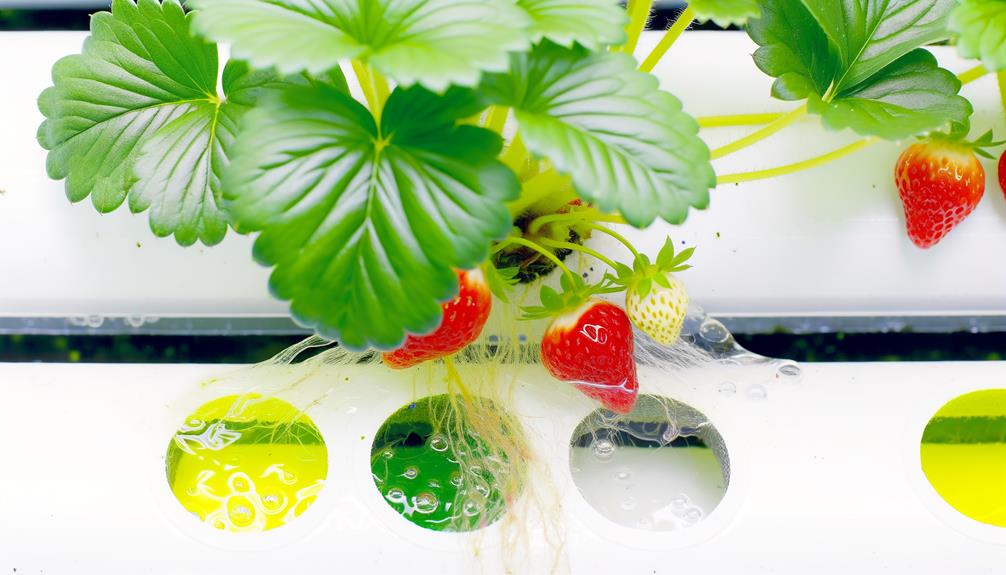
Selecting the ideal nutrient blend is crucial for maximizing strawberry yield and guaranteeing plant health in a hydroponic system. We need a precise balance of macro and micronutrients to enhance growth. Nitrogen (N), phosphorus (P), and potassium (K) are critical macronutrients. Additionally, micronutrients such as calcium (Ca), magnesium (Mg), and iron (Fe) play essential roles.
| Nutrient | Function |
|---|---|
| Nitrogen (N) | Promotes leaf growth |
| Phosphorus (P) | Enhances root development |
| Potassium (K) | Improves fruit quality |
| Calcium (Ca) | Strengthens cell walls |
To innovate, we should use chelated forms of micronutrients to boost absorption. Regular monitoring of Electrical Conductivity (EC) guarantees nutrient concentrations are optimal. Let's not forget pH management, maintaining levels between 5.8 and 6.2, to secure nutrient availability.
Balancing Cost and Yield
Striking the right balance between cost and yield in hydroponic strawberry cultivation requires meticulous planning and resource allocation to guarantee both profitability and high-quality produce.
We need to manage our investments in infrastructure, nutrients, and energy consumption while maximizing output. Here's how we achieve this balance:
- Nutrient Efficiency: Utilize precise nutrient formulations tailored to strawberries to avoid waste and reduce costs.
- Energy Management: Implement energy-efficient LED lighting and climate control systems to minimize electricity expenses.
- Water Conservation: Employ recirculating systems that reduce water usage and lower operational costs.
- Automation: Integrate automated monitoring and control systems to optimize growing conditions and reduce labor costs.
Conclusion
In our quest to cultivate the perfect hydroponic strawberries, we've navigated through various systems—NFT, DWC, drip irrigation, and aeroponics. Each is a unique brushstroke on our canvas.
By selecting the right nutrients and balancing cost with yield, we create a symphony of growth. Just as an artist chooses their palette, our choice of hydroponics and nutrients paints the masterpiece of our strawberry harvest.
Let's continue refining our methods to achieve the sweetest success.

